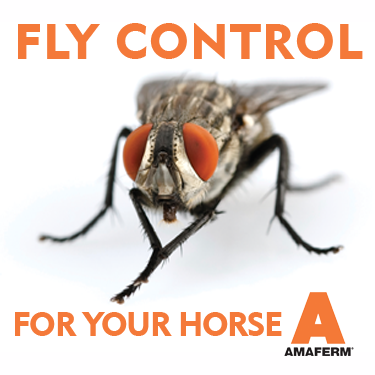 As the weather warms up, so do fly populations and it’s important to make sure your horse is well protected. Once spring hits, it’s generally time to get on with other jobs around the farm so your horse may not be attracting your attention, but it will be interesting the local fly population!
As the weather warms up, so do fly populations and it’s important to make sure your horse is well protected. Once spring hits, it’s generally time to get on with other jobs around the farm so your horse may not be attracting your attention, but it will be interesting the local fly population!
It may have been a long, cold winter – and no one, even if your from Texas, would argue about that – but it’s a myth that prolonged freezing temperatures kill off over-wintering fly populations. Entomologists tell us that they can actually survive deep in the soil and, in any case, heavy snow cover actually protects many flying insects from the extreme cold temperatures. What’s more, a cold winter followed by a warm and sunny March (which we are all praying for), can accelerate some fly cycles.
Flies and midges that affect horses are not only a nuisance and irritation to the animal, depressing performance, they can also transmit diseases. As the weather warms up, there are two main groups of flies which cause problems for horse owners: flies that bite and feed on blood; and flies that feed on the secretions from the eyes, nose and the sweat on the animal’s coat and skin. Within the two groups there are a number of different types of flies, some of which transmit disease, and others which are just a plain nuisance, but still distract the horse from being at its best.
Control of flies around your barn involves a combination of applying insecticides directly onto the animal, feeding Insect Growth Regulator (IGR) or garlic-based supplements, and cleaning up potential fly breeding sites.
Applying insecticides to deter flies
There are a number of fly spray products on the market that can be used to repel and kill flies. Although these products can be pricey, you can use them to meet the fly protection needs of your animals. There are a variety of different sprays on the market for you to choose from ranging from standard chemical based to newer non-toxic herbal alternatives. Regardless of which type you choose be sure to read the label for application instructions. Remember fly spray needs to be reapplied as animals sweat, get wet and after exposure to direct sunlight as this can lower the effectiveness of the repellent.
Feeding IGR to deter flies
Another way to break the fly life cycle is through feeding a supplement containing IGR. IGRs work by disrupting the pupa (molting) stage in the fly life cycle. IGR prevents the new exoskeleton from forming properly, causing the insect to die and never reach adulthood.
Although it is nearly impossible to remove all potential fly breeding grounds from your farm, IGR is a great way to help reduce the fly population. There should be a noticeable different in your fly population after two weeks of feeding IGR and full results will be seen within four to six weeks of feeding. If you are planning on introducing an IGR component to your fly prevention program, all animals on your property should be fed the IGR for maximum effectiveness. Ideally feeding should start 30 days before the last frost and continue until the first hard frost of the fall.
Feeding garlic to deter flies
For centuries, man has found garlic to be a potent supplement and tonic, for both themselves and the animals they depended on. As early as 5000 B.C., Egyptian hieroglyphics note the use of garlic, especially during the Nile Delta flood season when infestations of flies and mosquitoes were at their worst.
A number of studies have shown that the oil fraction of garlic can be effective against a wide range of insects. After ingestion, garlic creates an invisible odor barrier around animals. As flies “taste” with their feet, only they will know the animal smells and therefore taste bad. Humans will not be able to notice the difference. After a few days, horses offered these supplements will start to emit the strong garlic compounds through their skin. The strong smell can confuse flies and make it harder for them to seek out their next blood meal.
Cleaning up potential breeding sites to deter flies
Understanding how your own farm appeals to flies is an important step forward in better fly control. In fact, knowing where and when flies are breeding and then taking action to restrict the potential farm fly population is just as important as controlling flies on or around the animals.
Flies prefer damp, sheltered areas where they are protected from the wind and can find shade during the heat of the day. So your horse should be grazed on fields away from trees and water. Most of the flies that bite horses breed in dung or decomposing vegetable matter, and near water, so it is important to ensure their proliferation opportunities are as limited as possible by eliminating breeding hotspots around the farm – or keeping livestock well away from water.
It’s also a good idea to remove soiled bedding and spilled feed as often as possible, but at least once a week. Stored manure should be kept as dry and compacted as possible. Improving ventilation to reduce humidity and lower temperatures will also create less favorable breeding conditions for flies. Increasing air movement with fans also reduces stable fly nuisance. Keeping walls clean, feed pans empty and waterers very clean will also discourage flies.

